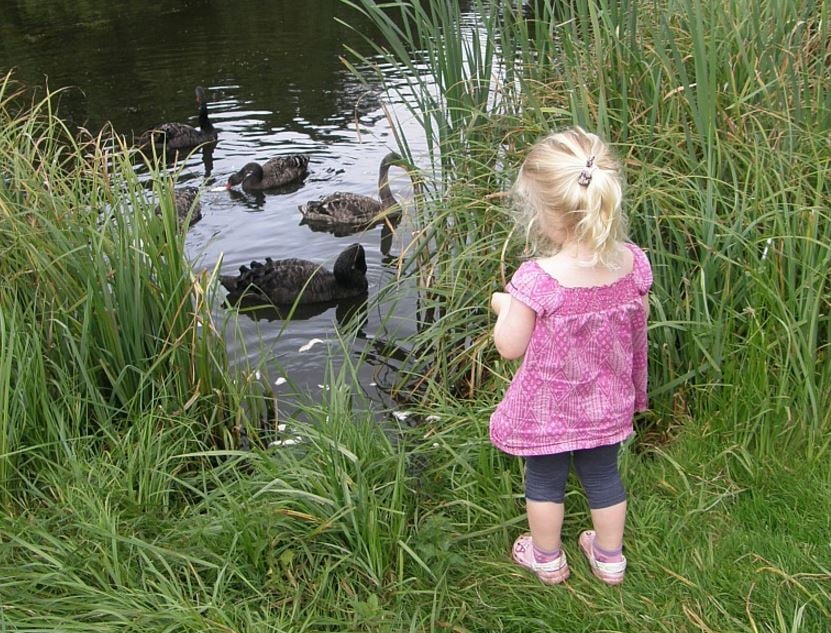Urban swans are comparatively friendly to humans compared to rural swans because their genes are different, says a team of Australian scientists. It is not simply because swans that live in towns and cities are more used to having people around.
Scientists from the University of Melbourne, Deakin University and Victoria University, explained in the open access journal BMC Evolutionary Biology that swans that are genetically predisposed to be timid are more likely to live in rural areas.
Study leader, Wouter van Dongen, and colleagues believe their findings may have major implications for releasing swans bred in captivity into the wild.
 These black swans are not scared off by the presence of a human partly because they are genetically programmed that way.
These black swans are not scared off by the presence of a human partly because they are genetically programmed that way.
Not just a question of getting used to humans
Before this study, most people including scientists had assumed that animals that lived in urban areas became less wary to humans through habituation, i.e. they got used to having people around. No research had ever been carried out which tested whether animals’ preference for a non-urban or urban environment might be determined by their genes.
In this latest study, the scientists carried out a series of tests to establish how shy two different populations of black swans (Cygnus atratus) were.
One population, consisting of eighty swans, lived in an urban parkland setting with lots of humans about. The other population comprised 20 swans that lived about 30 kilometres away in a rural area, with very few people about.
The birds’ wariness was quantified by walking slowly towards them until they flew away and measuring that distance, which is known as the FID (Flight Initiation Distance).
They also took blood samples from the two swan populations so that they could look for variations in two sets of genes – SERT and DRD4. These genes are linked to behaviours related harm avoidance and anxiety in humans.
Unsurprisingly, they found that the urban swans were considerably bolder than their rural counterparts. The urban swans’ average FID was 13 metres, compared to the rural swans’ 96 metres.
 The Flight Initiation Distance of the rural black swans was much longer than for their urban counterparts.
The Flight Initiation Distance of the rural black swans was much longer than for their urban counterparts.
Variants of DRD4 genotype detected
While no significant differences were found between the two populations in SERT genotypes, five different variants of DRD4 were detected, which were associated with varying levels of wariness.
Most of the urban swans (88.8%) shared the most common genotype for DRD4, while only 60% of the rural swans exhibited this genotype. Eighty-three percent of all the swans with the most common DRD4 genotype had a shorter FID (average), which suggests that their wariness is at least partly determined by their genes.
Swans can fly and migrate to different habitats, i.e. they can chose where to live. The researchers believe that the more wary ones deliberately select non-urban environments, while their bolder counterparts colonise urban areas.
Wouter van Dongen, said:
“Growing global urbanisation means that wild animals are increasingly settling near to humans. Although we often assume that animals become less wary of humans by simply getting used to them, our results suggest that at least part of this response might be genetically determined.”
“This has important implications for conservation, particularly for the introduction of animals bred in captivity, which could in future be screened for genotypes that are associated with wariness, allowing them to be released to a location commensurate with their expected wariness.”
Citation: “Variation at the DRD4 locus is associated with wariness and local site selection in urban black swans,” Wouter van Dongen, Randall Robinson, Michael Weston, Raoul Mulder and Patrick-Jean Guay. BMC Evolutionary Biology 2015. December, 11, 2015. DOI: 10.1186/s12862-015-0533-8.
Video – Black swans surfing in Australia
These black swans were spotted riding waves on the Gold Coast, Australia.
